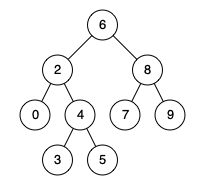LeetCode Link: 235. Lowest Common Ancestor of a Binary Search Tree
Language: C#
Problem Statement
Given a binary search tree (BST), find the lowest common ancestor (LCA) node of two given nodes in the BST.
According to the definition of LCA on Wikipedia: “The lowest common ancestor is defined between two nodes p and q as the lowest node in T that has both p and q as descendants (where we allow a node to be a descendant of itself).”
Examples
Example 1:

Input: root = [6,2,8,0,4,7,9,null,null,3,5], p = 2, q = 8
Output: 6
Explanation: The LCA of nodes 2 and 8 is 6.
Example 2

Input: root = [6,2,8,0,4,7,9,null,null,3,5], p = 2, q = 4
Output: 2
Explanation: The LCA of nodes 2 and 4 is 2, since a node can be a descendant of itself according to the LCA definition.
Example 3:
Input: root = [2,1], p = 2, q = 1
Output: 2
Constraints
- The number of nodes in the tree is in the range [2, 105].
- -109 <= Node.val <= 109
- All Node.val are unique.
- p != q
- p and q will exist in the BST.
Solution
/**
* Definition for a binary tree node.
* public class TreeNode {
* public int val;
* public TreeNode left;
* public TreeNode right;
* public TreeNode(int x) { val = x; }
* }
*/
public class Solution
{
public TreeNode LowestCommonAncestor(TreeNode root, TreeNode p, TreeNode q)
{
if (root is null)
{
return null;
}
if ((root.val >= p.val && root.val <= q.val) ||
(root.val <= p.val && root.val >= q.val))
{
return root;
}
if (root.val > p.val && root.val > q.val)
{
return LowestCommonAncestor(root.left, p, q);
}
return LowestCommonAncestor(root.right, p, q);
}
}
Complexity
Time Complexity: O(N)
Space Complexity: O(N)